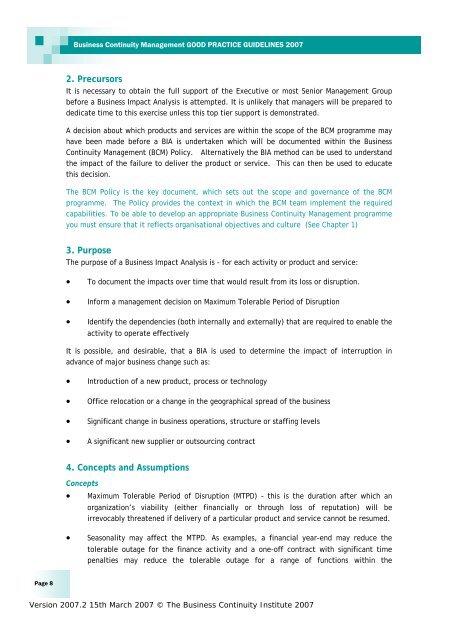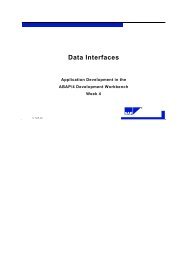business continuity institute good practice guidelines 2007
business continuity institute good practice guidelines 2007
business continuity institute good practice guidelines 2007
Create successful ePaper yourself
Turn your PDF publications into a flip-book with our unique Google optimized e-Paper software.
Page 8<br />
Business Continuity Management GOOD PRACTICE GUIDELINES <strong>2007</strong><br />
2. Precursors<br />
It is necessary to obtain the full support of the Executive or most Senior Management Group<br />
before a Business Impact Analysis is attempted. It is unlikely that managers will be prepared to<br />
dedicate time to this exercise unless this top tier support is demonstrated.<br />
A decision about which products and services are within the scope of the BCM programme may<br />
have been made before a BIA is undertaken which will be documented within the Business<br />
Continuity Management (BCM) Policy. Alternatively the BIA method can be used to understand<br />
the impact of the failure to deliver the product or service. This can then be used to educate<br />
this decision.<br />
The BCM Policy is the key document, which sets out the scope and governance of the BCM<br />
programme. The Policy provides the context in which the BCM team implement the required<br />
capabilities. To be able to develop an appropriate Business Continuity Management programme<br />
you must ensure that it reflects organisational objectives and culture (See Chapter 1)<br />
3. Purpose<br />
The purpose of a Business Impact Analysis is - for each activity or product and service:<br />
• To document the impacts over time that would result from its loss or disruption.<br />
• Inform a management decision on Maximum Tolerable Period of Disruption<br />
• Identify the dependencies (both internally and externally) that are required to enable the<br />
activity to operate effectively<br />
It is possible, and desirable, that a BIA is used to determine the impact of interruption in<br />
advance of major <strong>business</strong> change such as:<br />
• Introduction of a new product, process or technology<br />
• Office relocation or a change in the geographical spread of the <strong>business</strong><br />
• Significant change in <strong>business</strong> operations, structure or staffing levels<br />
• A significant new supplier or outsourcing contract<br />
4. Concepts and Assumptions<br />
Concepts<br />
• Maximum Tolerable Period of Disruption (MTPD) - this is the duration after which an<br />
organization’s viability (either financially or through loss of reputation) will be<br />
irrevocably threatened if delivery of a particular product and service cannot be resumed.<br />
• Seasonality may affect the MTPD. As examples, a financial year-end may reduce the<br />
tolerable outage for the finance activity and a one-off contract with significant time<br />
penalties may reduce the tolerable outage for a range of functions within the<br />
Version <strong>2007</strong>.2 15th March <strong>2007</strong> © The Business Continuity Institute <strong>2007</strong>
















